Mercedes-Benz E-Class: Occupant safety
 Mercedes-Benz E-Class: Occupant safety
Mercedes-Benz E-Class: Occupant safety
- Overview of occupant safety
- SRS (Supplemental Restraint System)
- Air bags
- Occupant Classification System (OCS)
- PRE-SAFE® (preventative occupant protection)
- NECK-PRO head restraints
- Resetting triggered NECK-PRO head restraints
- Seat belts
Overview of occupant safety
In this section, you will learn the most important facts about the restraint system components of the vehicle.
The restraint system consists of:
- seat belts
- child restraint systems
- LATCH-type (ISOFIX) child seat anchors
- dditional protection is provided by:
- SRS (Supplemental Restraint System)
- NECK-PRO head restraints
- PRE-SAFE®
- Air bag system components with:
- PASSENGER AIR BAG OFF indicator lamp
- front-passenger seat with Occupant
Classification System (OCS)
![]() WARNING
WARNING
Modifications to or work improperly
conducted on restraint system components
or their wiring, as well as tampering with
interconnected electronic systems, can lead
to the restraint systems no longer functioning
as intended.
Air bags or Emergency Tensioning Devices (ETDs), for example, could deploy inadvertently or fail to deploy in accidents although the deceleration threshold for air bag deployment is exceeded. Therefore, never modify the restraint systems. Do not tamper with electronic components or their software.
See "Children in the vehicle" for more information on infants and children traveling with you in the vehicle and restraints for infants and children.
SRS (Supplemental Restraint System)
Introduction
SRS consists of:
- the  SRS
warning lamp
SRS
warning lamp
- air bags
- air bag control unit (with crash sensors)
- Emergency Tensioning Devices
- belt force limiters
SRS reduces the risk of occupants coming into contact with the vehicle's interior in the event of an accident. It can also reduce the effect of the forces to which occupants are subjected during an accident.
SRS warning lamp
SRS functions are checked regularly when you switch on the ignition and when the engine is running. Therefore, malfunctions can be detected in good time.
The  SRS warning lamp in the
instrument
cluster lights up when the ignition is switched
on. It goes out no later than a few seconds
after the engine is started.
SRS warning lamp in the
instrument
cluster lights up when the ignition is switched
on. It goes out no later than a few seconds
after the engine is started.
The SRS components are in operational
readiness when the  SRS warning lamp
is not lit while the engine is running.
SRS warning lamp
is not lit while the engine is running.
![]() WARNING
WARNING
The SRS self-check has detected a
malfunction if the  SRS warning
lamp:
SRS warning
lamp:
- does not come on at all
- fails to go out approximately 4 seconds
after the engine was started
- comes on after the engine was started or
while driving
For your safety, Mercedes-Benz strongly recommends that you have the system checked as soon as possible at an authorized Mercedes-Benz Center. Otherwise the SRS may not be activated when it is needed in an accident, which could result in serious or fatal injury. The SRS might also deploy unexpectedly and unnecessarily which could also result in injury.
In addition, improper work on the SRS creates a risk of rendering the SRS inoperative or causing unintended air bag deployment. Work on the SRS must therefore only be performed by qualified technicians. Contact an authorized Mercedes-Benz Center.
If it is necessary to modify an air bag system to accommodate a person with disabilities, contact an authorized Mercedes-Benz Center for details. USA only: Call our Customer Assistance Center at 1-800-FOR-MERCedes (1-800-367-6372) for details.
Safety guidelines for seat belts, Emergency Tensioning Devices (ETDs) and air bags
![]() WARNING
WARNING
- Damaged seat belts or seat belts that have
been subjected to stress in an accident
must be replaced. Their anchoring points
must also be checked. Only use seat belts
installed or supplied by an authorized
Mercedes-Benz Center.
- Air bags and pyrotechnic Emergency Tensioning Devices (ETDs) contain perchlorate material, which may require special handling and regard for the environment. Check your national disposal guidelines. California residents, see www.dtsc.ca.gov/HazardousWaste/ Perchlorate/index.cfm.
- Air bags and ETDs are designed to function on a one-time-only basis. An air bag or ETD that has deployed must be replaced. PRESAFE ® has electrically operated reversible belt tensioners in addition to the pyrotechnic ETDs.
- Do not pass seat belts over sharp edges.
They could tear.
- Do not make any modification that could
change the effectiveness of the seat belts.
- Do not bleach or dye seat belts as this may
severely weaken them. In a crash they may
not be able to provide adequate protection.
- No modifications of any kind may be made
to any components or wiring of the SRS.
- Do not change or remove any component
or part of the SRS.
- Do not install additional trim material, seat
covers, badges, etc. to the:
- padded steering wheel boss
- knee bag covers
- front-passenger air bag cover
- outer side of front seat bolsters
- side trim next to the rear seat backrest
- roof lining trim
- Do not install additional electrical/ electronic equipment on or near SRS components and wiring.
RKeep area between air bags and occupants free of objects (e.g. packages, purses, umbrellas, etc.).
- Do not hang items such as coat hangers from the coat hooks or handles over the door. These items may be thrown around in the vehicle and cause head and other injuries when the window curtain air bag is deployed.
- Air bag system components will be hot after an air bag has inflated. Do not touch them.
- Never place your feet on the instrument panel, dashboard, or on the seat. Always keep both feet on the floor in front of the seat.
- Improper repair work on the SRS creates a risk of rendering the SRS inoperative or causing unintended air bag deployment.
Work on the SRS must therefore only be performed by qualified technicians.
Contact an authorized Mercedes-Benz Center.
- For your protection and the protection of others, when scrapping the air bag unit or ETD, our safety instructions must be followed. These instructions are available from any authorized Mercedes-Benz Center.
- Given the considerable deployment speed, required inflation volume, and the material of the air bags, there is the possibility of abrasions or other, potentially more serious injuries resulting from air bag deployment.
If you sell your vehicle, Mercedes-Benz strongly recommends that you inform the subsequent owner that the vehicle is equipped with SRS. Also, refer them to the applicable section in the Operator's Manual.
Air bags
Important safety notes
![]() WARNING
WARNING
Air bags are designed to reduce the incidence
of injuries and fatalities in certain situations:
- frontal impacts (driver's and frontpassenger
front air bags and driver's knee
bag)
- side impacts (side impact air bags, window
curtain air bags and pelvis air bags)
- rollover (window curtain air bags)
However, no system available today can completely eliminate injuries and fatalities.
When the air bags are deployed, a small amount of powder is released. The powder generally does not constitute a health hazard and does not indicate that there is a fire in the vehicle. In order to prevent potential breathing difficulties, you should leave the vehicle as soon as it is safe to do so. If you have any breathing difficulty but cannot get out of the vehicle after the air bag inflates, then get fresh air by opening a window or door.
![]() WARNING
WARNING
To reduce the risk of injuries during front air
bag inflation, the driver and front-passenger
must always be seated correctly and have
their seat belts fastened accordingly.
For maximum protection in the event of a collision, you must always be in the normal seat position with your back against the backrest. Fasten your seat belt and make sure that it is correctly positioned on your body.
Since the air bag inflates with considerable speed and force, a proper seating position and correct positioning of the hands on the steering wheel will help to keep you at a safe distance from the air bag. Occupants who are not wearing their seat belt, are not seated properly or are too close to the air bag can be seriously injured or killed by an air bag as it inflates with great force instantaneously:
- Sit with the seat belt properly fastened in a position that is as upright as possible with your back against the seat backrest.
- Move the driver's seat as far back as possible, still permitting proper operation of vehicle controls. The distance from the center of the driver's chest to the center of the air bag cover on the steering wheel must be at least 10 inches (25 cm) or more.
You should be able to accomplish this by adjusting the seat and steering wheel. If you have any difficulties, please contact an authorized Mercedes-Benz Center.
- Do not lean your head or chest close to the steering wheel or dashboard.
- Only hold the steering wheel by the rim.
Placing hands and arms inside the rim can increase the risk and potential severity of hand/arm injury when the driver front air bag inflates.
- Adjust the front-passenger seat as far back as possible from the dashboard when the seat is occupied.
- Occupants, especially children, should never place their bodies or lean their heads in the area of the door where the side impact air bag inflates. This could result in serious injuries or death should the side impact air bag be deployed. Always sit as upright as possible, wear the seat belt properly and use an appropriately sized child restraint, infant restraint or booster seat recommended for the size and weight of the child.
Failure to follow these instructions can result in severe injuries to you or other occupants.
If you sell your vehicle, it is important that you make the buyer aware of this safety information. Be sure to give the buyer this Operator's Manual.
![]() WARNING
WARNING
Accident research shows that the safest place
for children in an automobile is in a rear seat.
A side impact air bag related injury may occur if occupants, especially children, are not properly seated or restrained when next to a side impact air bag which needs to deploy rapidly in a side impact in order to do its job.
To help avoid the possibility of injury, please follow these guidelines:
(1) Always sit as upright as possible and use the seat belts properly.
Make sure that children 12 years old and under use an appropriately sized child restraint, infant restraint, or booster seat recommended for the size and weight of the child.
(2) Always wear seat belts properly.
The air bags are only deployed if the air bag control unit detects the need for deployment.
Only in the event of such a situation will they provide their supplemental protection.
The driver and passenger should always wear their seat belts. Otherwise, it is not possible for the air bags to provide their supplemental protection.
In the event of other types of impacts and impacts below air bag deployment thresholds, the air bags will not deploy. The driver and passengers will then be protected to the extent possible by a properly fastened seat belt. A properly fastened seat belt is also needed to provide the best possible protection in a rollover.
Air bags provide additional protection; they are not, however, a substitute for seat belts.
All vehicle occupants must fasten their seat belts regardless of whether your vehicle is equipped with air bags or not.
It is important for your safety and that of your passenger to have deployed air bags replaced and to have any malfunctioning air bags repaired. This will help to make sure the air bags continue to perform their protective function for the vehicle occupants in the event of a crash.
Front air bags
The front air bags increase protection for the driver's and front-passenger's head and chest.
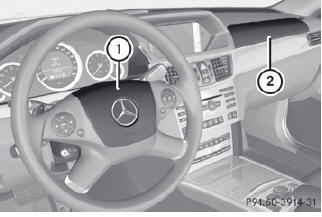
Driver's air bag 1 deploys in front of the steering wheel; front-passenger front air bag 2 deploys in front of and above the glove box.
They are deployed:
- in the event of certain frontal impacts - if the system determines that air bag deployment can offer additional protection to that provided by the seat belt - if the seat belt is fastened - independently of other air bags in the vehicle
If the vehicle overturns, the front air bags are generally not deployed unless the system detects high vehicle deceleration in a longitudinal direction.
Your vehicle has adaptive, two-stage front air bags. In the event of a collision, the air bag control unit evaluates the vehicle deceleration. In the first deployment stage, the front air bag is filled with enough propellant gas to reduce the risk of injuries.
The front air bag is fully deployed if a second deployment threshold is exceeded within a few milliseconds.
The deployment of the front-passenger front air bag is also influenced by the weight category of the front passenger, which is determined by the Occupant Classification System (OCS) (Y page 44).
The lighter the passenger side occupant, the higher the vehicle deceleration rate required (predicted at the start of the impact) for second stage inflation of the front-passenger front air bag. In the second stage, the front air bags are inflated with the maximum amount of propellant gas available.
The front air bags are not deployed in situations where a low impact severity is predicted. You will then be protected by the fastened seat belt.
The front-passenger front air bag will only deploy if:
- the system, based on the OCS weight sensor readings, detects that the frontpassenger seat is occupied.
- the  indicator lamp in the center
console is not lit.
indicator lamp in the center
console is not lit.
- the air bag control unit predicts a high impact severity.
Driver's knee bag
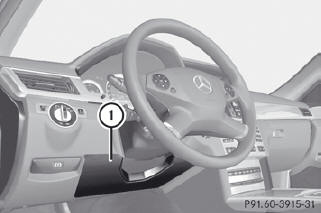
Driver's knee bag 1 provides additional protection for the driver against:
- knee injuries
- thigh injuries
- lower leg injuries
Driver's knee bag 1 deploys below the steering wheel. During a frontal impact, if the system determines that air bag deployment can offer additional protection to that provided by the seat belt, driver's knee bag 1 is deployed along with the driver's air bag. The driver's knee bag 1 operates best in conjunction with a properly positioned and fastened seat belt.
Side impact air bags
![]() WARNING
WARNING
The pressure sensors for side impact air bag
control are located in the doors. Do not
modify any components of the doors or door
trim panels including, for example, the
addition of door speakers.
Improper repair work on the doors or the modification or addition of components to the doors create a risk of rendering the side impact air bags inoperative or causing unintended air bag deployment. Work on the doors must therefore only be performed by qualified technicians. Contact an authorized Mercedes-Benz Center.
![]() WARNING
WARNING
Only use seat covers which have been tested
and approved by Mercedes-Benz for your
vehicle model. Using seat covers or other seat
coverings can cause a malfunction of the side
impact air bags and/or the pelvis air bags.
Contact an authorized Mercedes-Benz Center for availability.
When deployed, the side impact air bags offer additional protection for the thorax of the vehicle occupants on the side of the vehicle on which the impact occurs. However, they do not protect the:
- head
- neck
- arms
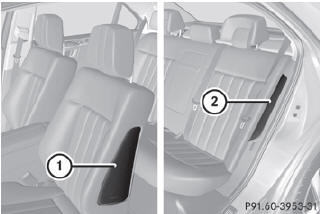
Example: Sedan
Front side impact air bags 1 and rear side impact air bags 2 deploy next to the outer seat cushions.
The side impact air bags are deployed:
- on the side on which an impact occurs
- at the start of an accident with a high rate
of lateral vehicle deceleration or
acceleration, e.g. in a side impact
- independently of seat belt use
- independently of the front air bags
- independently of the ETDs
If the vehicle overturns, the side impact air bags are generally not deployed. They are deployed if the system detects high vehicle deceleration or acceleration in a lateral direction and determines that side impact air bag deployment can offer additional protection to that provided by the seat belt.
Side impact air bags will not deploy in side impacts which do not exceed the system's preset deployment thresholds for lateral acceleration/deceleration. You will then be protected by the fastened seat belt.
If the OCS detects that the front-passenger seat is not occupied and the front-passenger seat belt is not fastened (the belt tongue is not engaged in the seat belt buckle), the side impact air bag on the front-passenger side will not deploy. The side impact air bag on the front-passenger side will deploy if the frontpassenger seat belt is fastened, regardless of whether the front-passenger seat is occupied or not.
Pelvis air bags
![]() WARNING
WARNING
Only use seat covers which have been tested
and approved by Mercedes-Benz for your
vehicle model. Using seat covers or other seat
coverings can cause a malfunction of the side
impact air bags and/or the pelvis air bags.
Contact an authorized Mercedes-Benz Center for availability.
Pelvis air bag deployment enhances the level of protection of the vehicle occupants on the side of the vehicle on which the impact occurs.
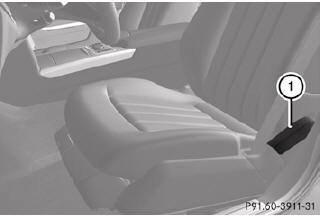
Pelvis air bags 1 deploy next to and below the outer seat cushions. They are deployed:
- on the side on which an impact occurs
- at the start of an accident with a high rate
of lateral vehicle deceleration or
acceleration, e.g. in a side impact
- independently of seat belt use
- independently of the front air bags
- independently of the ETDs
The pelvis air bags are generally not deployed if the vehicle overturns, unless the system detects high vehicle deceleration or acceleration in a lateral direction and determines that they can offer additional protection to that provided by the seat belt.
Pelvis air bags 1 will not deploy in side impacts which do not exceed the system's preset deployment thresholds for lateral acceleration/deceleration. You will then be protected by the fastened seat belt.
Vehicles with OCS (USA only): if the OCS detects that the front-passenger seat is not occupied and the front-passenger seat belt is not fastened (the belt tongue is not engaged in the seat belt buckle), the pelvis air bag on the front-passenger side will not deploy. The pelvis air bag on the front-passenger side will deploy if the front-passenger seat belt is fastened, regardless of whether the frontpassenger seat is occupied or not.
Window curtain air bags
The window curtain air bags enhance the level of protection for the head, but not chest or arms, of the vehicle occupants on the side of the vehicle on which the impact occurs.
The window curtain air bags are integrated into the side of the roof frame and deploy in the area from the A-pillar to the C-pillar.
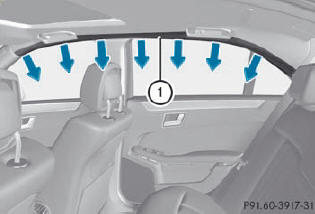
Example: Sedan Window curtain air bags 1 are deployed:
- on the side on which an impact occurs
- at the start of an accident with a high rate
of lateral vehicle deceleration or
acceleration, e.g. in a side impact
- regardless of whether the front-passenger
seat is occupied
- independently of seat belt use
- if the vehicle overturns and the system
determines that window curtain air bag
deployment can offer additional protection
to that provided by the seat belt
- independently of the front air bags
Window curtain air bags 1 will not deploy in impacts with deceleration rates which do not exceed the system's preset deployment thresholds for vehicle deceleration or acceleration. You will then be protected by the fastened seat belt.
Occupant Classification System (OCS)
How the occupant classification system works
The Occupant Classification System (OCS) categorizes the occupant on the front - passenger seat by means of a weight sensor.
The front-passenger front air bag is
deactivated automatically for certain weight
categories. The  indicator lamp
shows you the current status. If the
indicator lamp
shows you the current status. If the
 indicator lamp is illuminated, the
front-passenger front air bag is deactivated.
indicator lamp is illuminated, the
front-passenger front air bag is deactivated.
The system does not deactivate:
- the side impact air bag
- the pelvis air bag
- the window curtain air bag
- the Emergency Tensioning Devices
To be classified correctly, the front passenger
must sit:
- with the seat belt fastened correctly
- in a position that is as upright as possible
with their back against the seat backrest
- with their feet on the floor
If the front-passenger's weight is transferred to another object in the vehicle (e.g. by leaning on armrests), OCS may not be able to approximate the occupant's weight category.
If the front-passenger seat, the seat cover or the seat cushion are damaged, have the necessary repair work carried out at an authorized Mercedes-Benz Center.
For safety reasons, Mercedes-Benz recommends that you only use seat accessories which have been approved by Mercedes-Benz.
Both the driver and the passenger should
always use the  indicator lamp as
an indication of whether or not the passenger
is properly positioned.
indicator lamp as
an indication of whether or not the passenger
is properly positioned.
![]() WARNING
WARNING
If the  indicator lamp
illuminates
when an adult or someone larger than a small
individual is in the front passenger seat, have
the front passenger reposition himself or
herself in the seat until the
indicator lamp
illuminates
when an adult or someone larger than a small
individual is in the front passenger seat, have
the front passenger reposition himself or
herself in the seat until the  indicator lamp goes out.
indicator lamp goes out.
In the event of a collision, the air bag control unit will not allow front passenger front air bag deployment when the OCS has classified the front passenger seat occupant as weighing as much as or less than a typical 12-month-old child in a standard child restraint or if the front passenger seat is classified as being empty.
When the OCS senses that the front passenger seat occupant is classified as being up to or less than the weight of a typical 12-month-old child in a standard child restraint, the indicator lamp will illuminate when the engine is started and remain illuminated. This indicates that the front passenger front air bag is deactivated.
When the OCS senses that the front
passenger seat is classified as being empty,
the  indicator lamp will illuminate
when the engine is started and remain
illuminated. This indicates that the front
passenger front air bag is deactivated.
indicator lamp will illuminate
when the engine is started and remain
illuminated. This indicates that the front
passenger front air bag is deactivated.
When the OCS senses that the front
passenger seat occupant is classified as
being heavier than the weight of a typical 12-
month-old child seated in a standard child
restraint or as being a small individual (such
as a young teenager or a small adult), the
 indicator lamp will illuminate for
approximately 6 seconds when the engine is
started. Depending on occupant weight
sensor readings from the seat, it will then
remain illuminated or go out. With the
indicator lamp will illuminate for
approximately 6 seconds when the engine is
started. Depending on occupant weight
sensor readings from the seat, it will then
remain illuminated or go out. With the
 indicator lamp illuminated, the
front passenger front air bag is deactivated.
indicator lamp illuminated, the
front passenger front air bag is deactivated.
With the  indicator lamp out, the
front passenger front air bag is activated.
indicator lamp out, the
front passenger front air bag is activated.
When the OCS senses that the front
passenger seat occupant is classified as an
adult or someone larger than a small
individual, the  indicator lamp will
illuminate for approximately six seconds
when the engine is started and then go out.
indicator lamp will
illuminate for approximately six seconds
when the engine is started and then go out.
This indicates that the front passenger front air bag is activated.
If the  indicator lamp is
illuminated,
the front passenger front air bag is
deactivated and will not be deployed.
indicator lamp is
illuminated,
the front passenger front air bag is
deactivated and will not be deployed.
If the  indicator lamp is not
illuminated, the front passenger front air bag
is activated and will be deployed
indicator lamp is not
illuminated, the front passenger front air bag
is activated and will be deployed
- in the event of certain frontal impacts
- if the impact exceeds a predetermined
triggering threshold
- independent of the side impact air bag or
pelvis air bag
If the front passenger front air bag is
deployed, the rate of inflation will be
influenced by
- the rate of vehicle deceleration as assessed
by the air bag control unit
- the front passenger's weight category as
identified by the OCS
For further information, see "Air bag display messages"
![]() WARNING
WARNING
According to accident statistics, children are
safer when properly restrained on the rear
seats than on the front-passenger seat. Thus,
we strongly recommend that children be
placed in the rear seats whenever possible.
Regardless of seating position, children 12 years old and under must be seated and properly secured in an appropriate infant restraint, toddler restraint, or booster seat recommended for the size and weight of the child.
The infant or child restraint must be properly secured with the vehicle's seat belt, the seat belt and Top Tether strap, or lower anchors and Top Tether strap, fully in accordance with the child seat manufacturer's instructions.
Occupants, especially children, should always sit as upright as possible, wear the seat belt properly and use an appropriately sized infant restraint, toddler restraint, or booster seat recommended for the size and weight of the child.
Children can be killed or seriously injured by an inflating air bag. Note the following important information when circumstances require you to place a child in the frontpassenger seat:
- Your vehicle is equipped with air bag technology designed to deactivate the front-passenger front air bag in your vehicle when the system senses the weight of a typical 12-month-old child or less along with the weight of a standard appropriate child restraint on the front-passenger seat.
- A child in a rear-facing child restraint on the front-passenger seat will be seriously injured or even killed if the front-passenger front air bag inflates in a collision which could occur under some circumstances, even with the air bag technology installed in your vehicle. The only means to eliminate this risk completely is never to place a child in a rear-facing child restraint in the frontpassenger seat. We therefore strongly recommend that you always place a child in a rear-facing child restraint on the rear seat.
- If you install a rear-facing child restraint on
the front-passenger seat, make sure the
 indicator lamp is illuminated,
indicating that the front-passenger front air
bag is deactivated. Should the
indicator lamp is illuminated,
indicating that the front-passenger front air
bag is deactivated. Should the  indicator lamp not illuminate or go out while
the restraint is installed, please check
installation. Periodically check the
indicator lamp not illuminate or go out while
the restraint is installed, please check
installation. Periodically check the
 indicator lamp while driving to
make sure that the
indicator lamp while driving to
make sure that the  indicator
lamp is illuminated. If the
indicator
lamp is illuminated. If the  indicator lamp goes out or remains out, do
not transport a child on the front-passenger
seat until the system has been repaired.
indicator lamp goes out or remains out, do
not transport a child on the front-passenger
seat until the system has been repaired.
A child in a rear-facing child restraint on the front-passenger seat will be seriously injured or even killed if the front-passenger front air bag inflates.
- If you place a child in a forward-facing child restraint on the front-passenger seat:
- move the seat as far back as possible
- use the proper child restraint recommended for the age, size and
weight of the child
- secure child restraint with the vehicle's
seat belt according to the child seat
manufacturer's instructions
- For children larger than the typical 12-
month-old child, the front-passenger front
air bag may or may not be activated.
If the driver's air bag deploys, this does not mean that the front-passenger front air bag also has to deploy.
The OCS may have detected that the seat:
- was empty or occupied by a person with a weight of up to or less than that of a typical 12-month-old child seated in a standard child restraint - was occupied by a small individual, such as a young teenager or a small adult - was occupied by a child in a child restraint system, whose weight is greater than that of a typical 12-month-old child.
These are examples of when the OCS deactivates the front-passenger front air bag.
Deactivation takes place although the collision fulfills the criteria for deploying the driver's air bag.
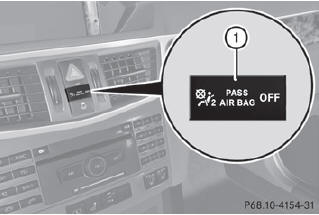
If the SmartKey has been removed from the
ignition lock or is in position 0, indicator lamp
 1 does not light up.
1 does not light up.
![]() WARNING
WARNING
If the red  SRS warning lamp in the
instrument cluster and the
SRS warning lamp in the
instrument cluster and the  indicator lamp light up simultaneously, the
OCS is malfunctioning. The front passenger
front air bag will be deactivated in this case.
indicator lamp light up simultaneously, the
OCS is malfunctioning. The front passenger
front air bag will be deactivated in this case.
Have the system checked by qualified technicians as soon as possible. Contact an authorized Mercedes-Benz Center.
Only have the seat repaired or replaced at an authorized Mercedes-Benz Center.
In order to ensure proper operation of the air bag system and OCS:
- Sit with the seat belt properly fastened in a
position that is as upright as possible with
your back against the seat backrest.
- When seated, a passenger should not
position him/herself in such a way as to
cause the passenger's weight to be lifted
from the seat cushion as this may result in
the OCS being unable to correctly
approximate the passenger's weight
category.
- Read and observe all warnings in this
chapter.
System self-test
The  indicator lamp illuminates
when you:
indicator lamp illuminates
when you:
- turn the SmartKey to position 1 or 2 in the
ignition lock
- on vehicles with KEYLESS-GO, press the
Start/Stop button once or twice
If an adult occupant is properly sitting on the
passenger seat and the OCS classifies the
occupant as an adult, the  indicator
lamp illuminates and goes out again after
approximately 6 seconds.
indicator
lamp illuminates and goes out again after
approximately 6 seconds.
If the seat is not occupied and the OCS
classifies the front passenger seat as being
unoccupied, the  indicator lamp
will illuminate and not go out.
indicator lamp
will illuminate and not go out.
![]() WARNING
WARNING
If the  indicator lamp does
not
illuminate, the system is not functioning. You
must contact an authorized Mercedes-Benz
Center before seating any child on the front
passenger seat.
indicator lamp does
not
illuminate, the system is not functioning. You
must contact an authorized Mercedes-Benz
Center before seating any child on the front
passenger seat.
For more information, see "Problems with the Occupant Classification System"
![]() WARNING
WARNING
Never place anything between seat cushion
and child seat (e.g. a pillow), since it reduces
the effectiveness of the OCS. The underside
and rear side child restraint system must be
placed entirely on the seat cushion and the
backrest of the front-passenger seat
backrest.
If necessary, adjust the tilt of the passenger seat backrest.
An incorrectly mounted child seat could cause injuries to the child in case of an accident, instead of increasing protection for the child.
Follow the manufacturer's instructions for installation of child restraint systems.
Problems with the occupant classification system
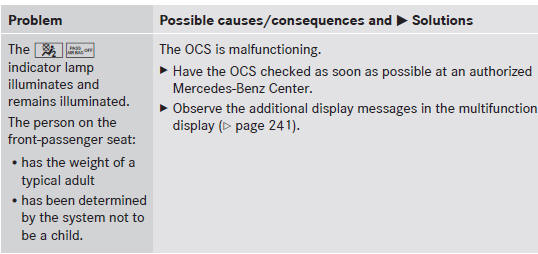
![]() WARNING
WARNING
If the  indicator lamp
illuminates and remains illuminated when the weight of a typical
adult or someone larger than a small individual has been detected on the
passenger seat, do not
allow any occupant to use the passenger seat until the system has been repaired.
indicator lamp
illuminates and remains illuminated when the weight of a typical
adult or someone larger than a small individual has been detected on the
passenger seat, do not
allow any occupant to use the passenger seat until the system has been repaired.
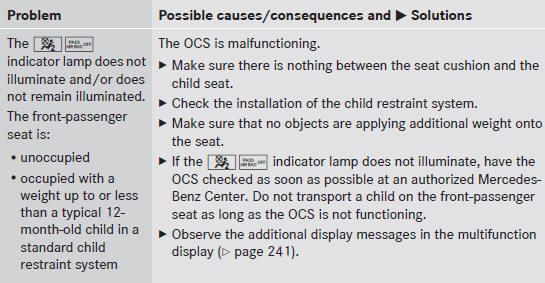
![]() WARNING
WARNING
If the  indicator lamp does not
illuminate or remains out with the weight of a typical
12-month-old child in a standard child restraint or less, or is unoccupied, on
the front-passenger
seat, do not transport a child on the front-passenger seat until the system has
been repaired.
indicator lamp does not
illuminate or remains out with the weight of a typical
12-month-old child in a standard child restraint or less, or is unoccupied, on
the front-passenger
seat, do not transport a child on the front-passenger seat until the system has
been repaired.
PRE-SAFE® (preventative occupant protection)
![]() WARNING
WARNING
The PRE-SAFE® system reduces the impact of
an accident on vehicle occupants, as long as
their seat belts have been fastened correctly.
Although your vehicle is equipped with a PRESAFE ® system, the possibility of injury in the event of an accident cannot be ruled out. You should therefore always drive carefully and adapt your driving style to the prevailing road, weather and traffic conditions.
PRE-SAFE® takes preemptive measures to protect occupants in certain hazardous situations.
PRE-SAFE® intervenes:
- in emergency braking situations, e.g. if BAS
is activated or, in vehicles with DISTRONIC
PLUS, BAS PLUS intervenes powerfully
- if the radar sensor system detects an
imminent danger of collision in certain
situations (on vehicles with DISTRONIC
PLUS)
- in critical driving situations, e.g. when
physical limits are exceed and the vehicle
understeers or oversteers severely
PRE-SAFE® takes the following measures depending on the hazardous situation detected:
- the front seat belts are pre-tensioned.
- it adjusts the front-passenger seat if it is in
an unfavorable position.
- the air pressure in the side bolsters of the
seat cushion and seat backrest of the front
active multicontour seats is increased.
- if the vehicle skids, the sliding sunroof/
panorama roof with power tilt/sliding
panel and the side windows are closed so
that only a small gap remains.
If the hazardous situation passes without resulting in an accident, PRE-SAFE® slackens the belt pretensioning. The air pressure in the side bolsters on the active multicontour seat
is reduced again. All settings made by PRESAFE ® can then be reversed.
If the seat belts are not released:
- Move the backrest or seat back slightly, but only when the vehicle is stationary.
The belt pretensioning is reduced and the locking mechanism is released.
![]() WARNING
WARNING
Make sure that nobody can become trapped
as you adjust the seat.
Make sure that there are no objects in the footwell or behind the seats when resetting the seats. There is a risk that the seats and/or the objects could be damaged.
More information about seat-belt adjustment, a convenience function integrated into PRE-SAFE®, can be found in the "Seat-belt adjustment" section
NECK-PRO head restraints
The NECK-PRO head restraints increase protection to the driver's and front passenger's head and neck. To this end, the NECK-PRO head restraints on the driver's and front-passenger seats are moved forwards and upwards in the event of a rear-end collision of a certain severity. This provides better head support.
![]() WARNING
WARNING
Do not secure any objects (e.g. coat hangers)
on the NECK-PRO head restraints. Otherwise,
the NECK-PRO head restraints may not
function properly, or in the event of a rear-end
collision may not be able offer the level of
protection they are designed to provide.
![]() WARNING
WARNING
Seat or head restraint covers can cause a
malfunction when the NECK-PRO head
restraints are activated or when the side
impact air bags or pelvis air bags are
deployed, or they can prevent this completely.
The NECK-PRO head restraints or side impact air bags/pelvis air bags can therefore not provide the intended protection. Do not use any seat or head restraint covers.
If the NECK-PRO head restraints have been triggered in an accident, reset the NECK-PRO head restraints on the driver’s and frontpassenger seat (Y page 51). Otherwise, the additional protection will not be available in the event of another rear-end collision. You can recognize when NECK-PRO head restraints have been triggered by the fact that they have moved forwards and can no longer be adjusted.
![]() WARNING
WARNING
For your protection, drive only with properly
positioned head restraints.
Adjust the head restraint so that it is as close to the head as possible and the center of the head restraint supports the back of the head at eye level. This will reduce the potential for injury to the head and neck in the event of an accident or similar situation.
Resetting triggered NECK-PRO head restraints
![]() WARNING
WARNING
For safety reasons, have the NECK-PRO head
restraints checked at an authorized
Mercedes-Benz Center after a rear-end
collision.
![]() WARNING
WARNING
When pushing back the NECK-PRO head
restraint cushion, make sure your fingers do
not become caught between the head
restraint cushion and the cover. Failure to
observe this could result in injuries.
Resetting the NECK-PRO head restraints requires a lot of strength. If you have difficulty resetting the NECK-PRO head restraints, have this work carried out at a qualified specialist workshop, e.g. an authorized Mercedes-Benz Center.
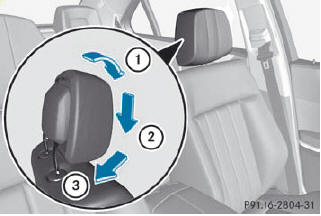
Example: Sedan
- Tilt the top of the NECK-PRO head restraint
cushion forwards in the direction of
arrow 1.
- Push the NECK-PRO head restraint cushion
down in the direction of arrow 2 as far as
it will go.
- Firmly push the NECK-PRO head restraint
cushion back in the direction of arrow 3
until the cushion engages.
- Repeat this procedure for the second
NECK-PRO head restraint.
Seat belts
Important safety notes
The use of seat belts and infant and child restraint systems is required by law in all 50 states, the District of Columbia, the U.S.
territories and all Canadian provinces.
Even where this is not the case, all vehicle occupants should have their seat belts fastened when the vehicle is in motion.
For further information on infants and children traveling in the vehicle and on infant and child restraint systems, see "Children in the vehicle"
![]() WARNING
WARNING
Always fasten your seat belt before driving off.
Always make sure all of your passengers are properly restrained. You and your passengers should always wear seat belts.
Failure to wear and properly fasten and position your seat belt greatly increases your risk of injuries and their likely severity in an accident.
If you are ever in an accident, your injuries can be considerably more severe without your seat belt properly buckled. Without your seat belt buckled, you are much more likely to hit the interior of the vehicle or be ejected from it. You can be seriously injured or killed.
In the same crash, the possibility of injury or death is lessened if you are properly wearing your seat belt. The air bags can only protect as intended if the occupants are properly wearing their seat belts.
![]() WARNING
WARNING
Never ride in a moving vehicle with the seat
backrest in an excessively reclined position as
this can be dangerous. You could slide under
the seat belt in a collision. If you slide under
it, the seat belt would apply force at the
abdomen or neck. That could cause serious
or even fatal injuries. The seat backrest and
seat belt provide the best restraint when the
wearer is in a position that is as upright as
possible and the seat belt is properly
positioned on the body.
![]() WARNING
WARNING
Never let more people ride in the vehicle than
there are seat belts available. Make sure
everyone riding in the vehicle is correctly
restrained with a separate seat belt. Never
use a seat belt for more than one person at a
time.
![]() WARNING
WARNING
Damaged seat belts or seat belts that have
been subjected to stress in an accident must
be replaced and their anchoring points must
also be checked.
Only use seat belts which have been approved
by Mercedes-Benz.
Do not make any modifications to the seat
belts. This can lead to unintended activation
of the ETDs or to their failure to activate when
necessary.
Do not bleach or dye seat belts as this may
severely weaken them. In a crash they may
not be able to provide adequate protection.
Have all work carried out only by qualified
technicians. Contact an authorized
Mercedes-Benz Center.
Correct use of the seat belts
![]() WARNING
WARNING
USE SEAT BELTS PROPERLY
- Seat belts can only work when used properly. Never wear seat belts in any other way than as described in this section, as that could result in serious injuries in the event of an accident.
- Each occupant should wear their seat belt at all times, because seat belts help reduce the likelihood of and potential severity of injuries in accidents, including rollovers.
The integrated restraint system includes SRS (driver front air bag, driver's side knee bag, front-passenger front air bag, side impact air bags, pelvis air bags, window curtain air bags for the side windows), Emergency Tensioning Devices, seat belt force limiters, and front seat knee bolsters.
The system is designed to enhance the protection offered to properly belted occupants in certain frontal (front air bags, driver's side knee bag and ETDs) and side (side impact air bags, window curtain air bags, and ETDs) impacts which exceed preset deployment thresholds and in certain rollovers (window curtain air bags and ETDs).
- Never wear the shoulder belt under your arm, across your neck or off your shoulder.
In a frontal crash, your body would move too far forward. That would increase the chance of head and neck injuries. The seat belt would also apply too much force to the ribs or abdomen, which could severely injure internal organs such as your liver or spleen.
Adjust the seat belt so that the shoulder section is located as close as possible to the middle of the shoulder. It should not touch the neck. Never pass the shoulder portion of the seat belt under your arm. For this purpose, you can adjust the height of the seat belt outlet.
- Position the lap belt as low as possible on
your hips and not across the abdomen. If
the lap belt is positioned across your
abdomen, it could cause serious injuries in
a crash.
- Never wear seat belts over rigid or
breakable objects in or on your clothing,
such as eyeglasses, pens, keys etc., as
these might cause injuries.
- Make sure the seat belt is always fitted
snugly. Take special care of this when
wearing loose clothing.
- Never use a seat belt for more than one
person at a time. Do not fasten a seat belt
around a person and another person or
other objects at the same time.
- Seat belts should not be worn twisted. In a
crash, you would not have the full width of
the seat belt to distribute impact forces.
The twisted seat belt against your body could cause injuries.
- Pregnant women should also always use a
lap-shoulder belt. The lap belt portion
should be positioned as low as possible on
the hips to avoid any possible pressure on
the abdomen.
- Place the seat backrest in a position that is
as upright as possible.
- Check your seat belt during travel to make
sure it is properly positioned.
- Never place your feet on the instrument
panel, dashboard, or on the seat. Always
keep both feet on the floor in front of the
seat.
- When using a seat belt to secure infant
restraints, toddler restraints, or children in
booster seats, always follow the child seat
manufacturer's instructions.
![]() WARNING
WARNING
Do not pass seat belts over sharp edges. They
could tear.
Do not allow the seat belt to get caught in the door or in the seat adjustment mechanism.
This could damage the seat belt.
Never attempt to make modifications to seat belts. This could impair the effectiveness of the seat belts.
Fastening seat belts
![]() WARNING
WARNING
According to accident statistics, children are
safer when properly restrained on the rear
seats than on the front-passenger seat. Thus,
we strongly recommend that children be
placed in the rear seat whenever possible.
Regardless of seating position, children 12 years old and under must be seated and properly secured in an appropriately sized child restraint system or booster seat recommended for the size and weight of the child. For additional information, see the "Children in the vehicle" section.
A child's risk of serious or fatal injuries is significantly increased if the child restraints are not properly secured in the vehicle and/ or the child is not properly secured in the child restraint.
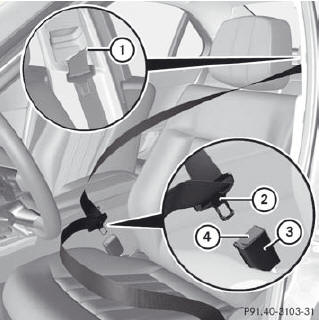
Example: Sedan
- Adjust the seat and move the backrest to an almost vertical position.
- Pull the seat belt smoothly through belt
sash guide 1.
- Without twisting it, guide the shoulder
section of the seat belt across the middle
of your shoulder and the lap section across
your hips.
- Engage belt tongue 2 in buckle 3.
Seat-belt adjustment: if necessary, the driver's and front-passenger seat belts automatically adjust to the upper body
- If necessary, adjust the seat belt to the
appropriate height.
- If necessary, pull upwards on the shoulder
section of the seat belt to tighten the belt
across your body.
All seat belts except the driver's seat belt are equipped with a special seat belt retractor to securely fasten child restraint systems in the vehicle. For further information on special seat belt retractors, see.
For more information about releasing the seat belt with release button 4, see "Releasing seat belts".
Seat belt adjustment
The seat-belt adjustment function adjusts the driver's and front-passenger seat belt to the upper body of the occupants.
The belt strap is tightened slightly when:
- you engage the belt tongue in the belt
buckle and you then turn the SmartKey to
position 2 in the ignition lock.
- the SmartKey is in position 2 in the ignition
lock and you then engage the belt tongue
in the buckle.
The seat-belt adjustment will apply a retraction force if any slack is detected between the occupant and the seat belt. Do not hold on to the seat belt tightly while it is adjusting. You can switch the seat-belt adjustment on and off in the on-board computer.
The seat-belt adjustment is an integral part of the PRE-SAFE® convenience function. More information about PRE-SAFE® can be found in the "PRE-SAFE® (preventative occupant protection)" section.
Belt height adjustment
You can adjust the seat belt height on the driver's seat and the front-passenger seat.
Wagon: you can also adjust the belt height on the outer rear seats.
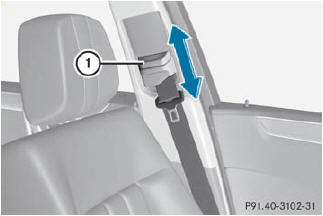
Adjust the height so that the upper part of the seat belt is routed across the center of your shoulder.
- To raise: slide the belt sash guide upwards.
The belt sash guide engages in various
positions.
- To lower: press and hold belt sash guide
release 1.
- Slide the belt sash guide downwards.
- Release belt sash guide release 1 and
make sure that the belt sash guide has
engaged.
Using the rear center seat belt
If the left-hand rear seat backrest is folded down and back up again, the rear center seat belt may lock. The seat belt can then not be pulled out.
To release the rear center seat belt:pull out the seat belt by the belt outlet on the backrest approximately 1 in (25 mm) and release it again.
The seat belt is retracted and released.
Releasing seat belts
- Press release button 4 and guide belt tongue ; back towards belt sash guide 1.
Make sure that the seat belt is fully rolled up. Otherwise, the seat belt or belt tongue will be trapped in the door or in the seat mechanism. This could damage the door, the door trim panel and the seat belt.
Damaged seat belts can no longer fulfill their protective function and must be replaced. Consult an authorized Mercedes- Benz Center.
Belt warning for the driver and front passenger
Regardless of whether the driver and front
passenger have fastened their seat belts
already, the  seat belt warning lamp
lights up for 6 seconds after every engine
start. It then goes out if the driver and the
front passenger have fastened their seat
belts.
seat belt warning lamp
lights up for 6 seconds after every engine
start. It then goes out if the driver and the
front passenger have fastened their seat
belts.
If the driver's seat belt is not fastened after the engine is started, an additional warning tone will sound. The warning tone goes out after approximately six seconds or once the driver's seat belt is fastened.
If the driver or front passenger have not
fastened their seat belt after 6 seconds and
the doors are closed, the  seat belt
warning lamp lights up.
seat belt
warning lamp lights up.
- until the driver or the front passenger have
fastened their seat belts
- if a vehicle speed of 15 mph(25 km/h) is
exceeded once, a warning tone with
increasing intensity sounds additionally for
a maximum of 60 seconds or until the driver
or front passenger have fastened their seat
belts.
If the driver or front passenger undo their seat
belts during the journey, the  seat
belt
warning lamp lights up and the warning tone
sounds again.
seat
belt
warning lamp lights up and the warning tone
sounds again.
The warning tone ceases even if the driver or
front passenger have still not fastened their
seat belt after 60 seconds. The  seat belt
warning lamp stops flashing but continues to
be lit.
seat belt
warning lamp stops flashing but continues to
be lit.
Once the vehicle is stationary, the warning
tone is reactivated and the  seat
belt
warning lamp starts to flash again if the
vehicle speed exceeds 15 mph(25 km/h)
once.
seat
belt
warning lamp starts to flash again if the
vehicle speed exceeds 15 mph(25 km/h)
once.
The  seat belt warning lamp only
goes
out if:
seat belt warning lamp only
goes
out if:
- both the driver and the front passenger
have fastened their seat belts.
or
- the vehicle is stationary and a door is open.
For more information on the  seat
belt warning lamp, see "Warning and
indicator lamps in the instrument cluster,
seat belt"
seat
belt warning lamp, see "Warning and
indicator lamps in the instrument cluster,
seat belt"
Emergency Tensioning Devices, belt force limiters
The front seat belts and the outer seat belts in the rear are equipped with ETDs and seat belt force limiters.
The ETDs tighten the seat belts in an accident, pulling them close against the body.
The ETDs do not correct incorrect seat positions or incorrectly fastened seat belts.
The ETDs do not pull vehicle occupants back towards the backrest.
Seat belt force limiters, when triggered, help to reduce the peak force exerted by the seat belt on the vehicle occupant.
The seat belt force limiters for the front seats are synchronized with the front air bags.
These take on a part of the deceleration force.
Thus, the force exerted on the occupant is distributed over a greater area.
The ETDs can only be activated when:
- the ignition is switched on.
- the restraint systems are operational; see
"SRS warning lamp".
- the belt tongue is engaged in the buckle on
each of the lap-shoulder belts in the front.
- the front-passenger seat is occupied and
the belt tongue is engaged in the buckle on
the front-passenger side.
The ETDs on the outside seats in the rear compartment are triggered independently of the lock status of the seat belts.
The ETDs are triggered depending on the type and severity of an accident:
- if, in the event of a head-on or rear-end
collision, the vehicle decelerates or
accelerates rapidly in a longitudinal
direction during the initial stages of the
impact
- if, in the event of a side impact, on the side
opposite the impact the vehicle decelerates or accelerates rapidly in a
lateral direction
- if, in certain situations where the vehicle
overturns, the system determines that it
can provide additional protection
If the air bags are deployed, you will hear a
bang, and a small amount of powder may also
be released. Only in rare cases will the bang
affect your hearing. The powder that is
released generally does not constitute a
health hazard. The  SRS warning lamp
lights up.
SRS warning lamp
lights up.
![]() WARNING
WARNING
Pyrotechnic Emergency Tensioning Devices
that have been deployed must be renewed.
For your safety, when disposing of Emergency Tensioning Devices, always observe the safety instructions. These are available from any authorized Mercedes-Benz Center.
The PRE-SAFE® system has electrically operated reversible pre-tensioners that do not require replacement after activation.
If the front-passenger seat is not occupied, do not engage the seat belt tongue in the buckle on the frontpassenger seat. Otherwise, the Emergency Tensioning Device could be triggered in the event of an accident.


